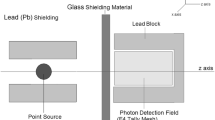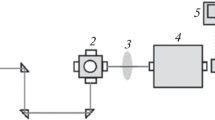The Judd–Ofelt parameters are calculated for Tb3+ ions in yttrium-aluminum-borate glasses coactivated by Tb3+ and Ce3+ (X1) and activated solely by Tb3+ (X2). The following parameters are obtained: Ω2 = 5.45 × 10 –20, Ω4 = 2.82 × 10 –20, Ω6 = 3.76 × 10 –20 cm2 for X1 and Ω2 = 4.99 × 10 –20, Ω4 = 2.18 × 10 –20, Ω6 = 3.51 × 10 –20 cm2 for X2. It is shown that these glasses hold promise as a basis for the development of converters of UV-radiation into the green-yellow region of the spectrum.


Similar content being viewed by others
References
A. J. Kenyon, “Recent developments in rare-earth doped materials for optoelectronics,” Progr. Quantum Electronics, 26, 225 – 284 (2002).
E. Snitzer, “Optical maser action of Nd+3 in a barium crown glass,” Phys. Rev. Lett., 7, 444 – 446 (1961).
C. J. Koester and E. Snitzer, “Amplification in a fiber laser,” Appl. Optics, 3, 1182 – 1186 (1964).
B. R. Judd, “Optical absorption intensities of rare-earth ions,” Phys. Rev., 127, 750 – 761 (1962).
G. S. Ofelt, “Intensities of crystal spectra of rare earth ions,” J. Chem. Phys., 37(3), 511 – 520 (1962).
G. M. Kuz’micheva, Structural Conditionality of Properties. Pt IV: Crystal Chemistry of Materials of Nonlinear Optics; Crystal Chemistry of Piezoelectrics; Crystal Chemistry of Jewelry Crystals [in Russian], MITKhT, Moscow (2004).
A. V. Malakhovskii, A. É. Sokolov, V. L. Temerov, et al., “Polarized absorption spectral and spectroscopic parameters of Tm3+ in TmAl3 (BO3)4 ,” Fiz. Tverd. Tela, 50(7), 1239 – 1242 (2008).
L. M. Dorozhkin, I. I. Kuratev, V. A. Zhitnyuk, et al., “Nonlinear optical properties of neodymium yttrium aluminum borate crystals,” Sov. J. Quant. Electron., 13(7), 978 – 980 (1983).
G. E. Malashkevich, V. N. Sigaev, N. V. Golubev, et al., “Spectroscopic properties of Sm-containing yttrium-aluminoborate glasses and analogous huntite-like polycrystals,” Mater. Chem. Phys., 137, 48 – 54 (2012).
G. E. Malashkevich, N. V. Golubev, E. Kh. Mamadzhanova, et al., “Oxide glass with minimum distance 0.67 nm between rare-earth activators,” Steklo Keram., No. 4, 33 – 34 (2013); G. E. Malashkevich, N. V. Golubev, E. Kh. Mamadzhanova, et al., “Oxide glass with minimum distance 0.67 nm between rare-earth activators,” Glass Ceram., 70(3 – 4), 141 – 142 (2013).
E. Kh. Mamadzhanova, N. V. Golubev, V. N. Sigaev, et al., “Crystallization and luminescence properties of (Sm x Y1–x )2O3 –Al2O3 –B2O3 glass,” Steklo Keram., No. 11, 14 – 19 (2012); E. Kh. Mamadzhanova, N. V. Golubev, V. N. Sigaev, et al., “Crystallization and luminescence properties of (Sm x Y1–x )2O3 –Al2O3 –B2O3 glass,” Glass Ceram., 69(11 – 12), 370 – 374 (2012).
G. Amaranath, S. Buddhudu, and F. J. Bryant, “Spectroscopic properties of Tb3+-doped fluoride glasses,” J. Non-Cryst. Solids, 122, 66 – 73 (1990).
W. T. Carnall, P. R. Fields, and K. Ranjak, “Electronic energy levels of the trivalent lanthanide aqua ions. III. Tb3+,” J. Chem. Phys., 49(10), 4447 – 4449 (1968).
O. P. Plata, A. Florez Londono, and A. Herrera Carrillo, “Fabricacion y Caracterizacionoptica de Vidriosfluoroindatosdopados Con el Ion Tb3+,” BISTUA, 5(1), 53 – 60 (2007).
W. T. Carnall, P. R. Fields, and K. Ranjak, “Spectral intensities of the trivalent lanthanides and actinides in solution. II. Pm3+, Sm3+, Eu3+, Gd3+, Tb3+, Dy3+, and Ho3+,” J. Chem. Phys., 49(10), 4412 – 4423 (1968).
K. Binnemans and C. Corller-Walrand, “Are the Judd–Ofelt intensity parameters sensitive enough to reflect small compositional changes in lanthanide-doped glasses,” J. Phys: Condens. Matter., 10, L167 – L170 (1998).
H. Ebendorff-Heidepriem and D. Ehrt, “Tb3+ f–d absorption as indicator of the effect of covalency on the Judd–Ofelt Ω2 parameter in glasses,” J. Non-Cryst. Solids, 248, 247 – 252 (1999).
This work was supported by the Ministry of Education and Science of the Russian Federation (grants MK-1398.2014.3 and 14.Z50.31.0009).
Author information
Authors and Affiliations
Corresponding author
Additional information
Translated from Steklo i Keramika, No. 10, pp. 17 – 20, October, 2015.
Rights and permissions
About this article
Cite this article
Ziyatdinova, M.Z., Golubev, N.V., Ignat’eva, E.S. et al. Spectroscopic Properties of Yttrium-Aluminum-Borate Glasses Activated by Terbium and Cerium Ions. Glass Ceram 72, 366–369 (2016). https://doi.org/10.1007/s10717-016-9791-1
Published:
Issue Date:
DOI: https://doi.org/10.1007/s10717-016-9791-1




